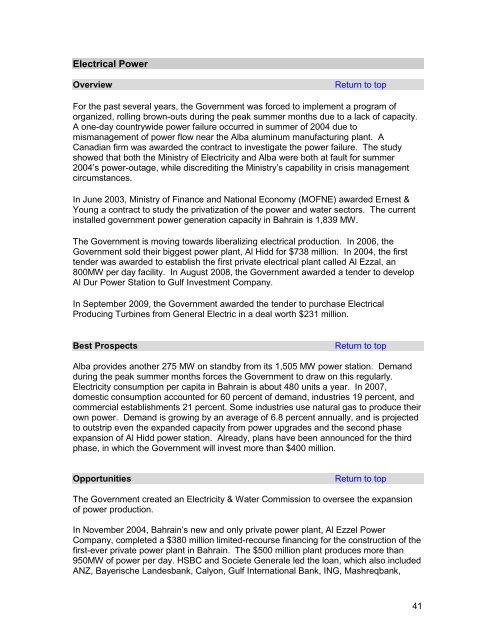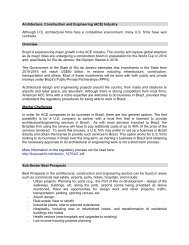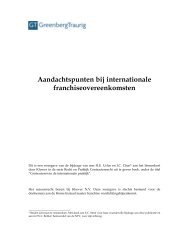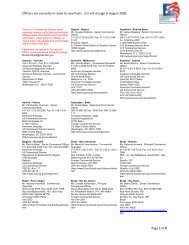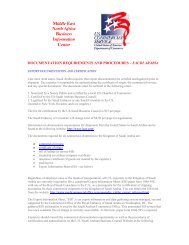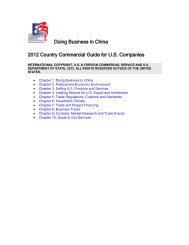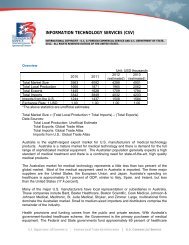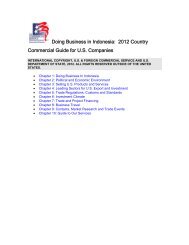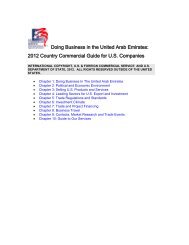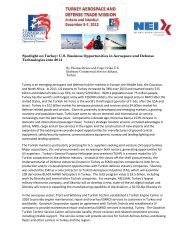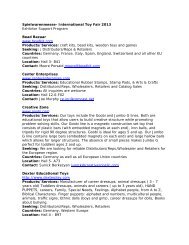2011 Bahrain Country Commercial Guide - US - Export.gov
2011 Bahrain Country Commercial Guide - US - Export.gov
2011 Bahrain Country Commercial Guide - US - Export.gov
Create successful ePaper yourself
Turn your PDF publications into a flip-book with our unique Google optimized e-Paper software.
Electrical Power<br />
Overview Return to top<br />
For the past several years, the Government was forced to implement a program of<br />
organized, rolling brown-outs during the peak summer months due to a lack of capacity.<br />
A one-day countrywide power failure occurred in summer of 2004 due to<br />
mismanagement of power flow near the Alba aluminum manufacturing plant. A<br />
Canadian firm was awarded the contract to investigate the power failure. The study<br />
showed that both the Ministry of Electricity and Alba were both at fault for summer<br />
2004‘s power-outage, while discrediting the Ministry‘s capability in crisis management<br />
circumstances.<br />
In June 2003, Ministry of Finance and National Economy (MOFNE) awarded Ernest &<br />
Young a contract to study the privatization of the power and water sectors. The current<br />
installed <strong>gov</strong>ernment power generation capacity in <strong>Bahrain</strong> is 1,839 MW.<br />
The Government is moving towards liberalizing electrical production. In 2006, the<br />
Government sold their biggest power plant, Al Hidd for $738 million. In 2004, the first<br />
tender was awarded to establish the first private electrical plant called Al Ezzal, an<br />
800MW per day facility. In August 2008, the Government awarded a tender to develop<br />
Al Dur Power Station to Gulf Investment Company.<br />
In September 2009, the Government awarded the tender to purchase Electrical<br />
Producing Turbines from General Electric in a deal worth $231 million.<br />
Best Prospects Return to top<br />
Alba provides another 275 MW on standby from its 1,505 MW power station. Demand<br />
during the peak summer months forces the Government to draw on this regularly.<br />
Electricity consumption per capita in <strong>Bahrain</strong> is about 480 units a year. In 2007,<br />
domestic consumption accounted for 60 percent of demand, industries 19 percent, and<br />
commercial establishments 21 percent. Some industries use natural gas to produce their<br />
own power. Demand is growing by an average of 6.8 percent annually, and is projected<br />
to outstrip even the expanded capacity from power upgrades and the second phase<br />
expansion of Al Hidd power station. Already, plans have been announced for the third<br />
phase, in which the Government will invest more than $400 million.<br />
Opportunities Return to top<br />
The Government created an Electricity & Water Commission to oversee the expansion<br />
of power production.<br />
In November 2004, <strong>Bahrain</strong>‘s new and only private power plant, Al Ezzel Power<br />
Company, completed a $380 million limited-recourse financing for the construction of the<br />
first-ever private power plant in <strong>Bahrain</strong>. The $500 million plant produces more than<br />
950MW of power per day. HSBC and Societe Generale led the loan, which also included<br />
ANZ, Bayerische Landesbank, Calyon, Gulf International Bank, ING, Mashreqbank,<br />
41


